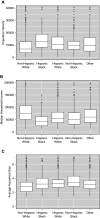Association of Race and Ethnicity with COVID-19 Test Positivity and Hospitalization Is Mediated by Socioeconomic Factors
- PMID: 33724166
- PMCID: PMC8513657
- DOI: 10.1513/AnnalsATS.202011-1448OC
Association of Race and Ethnicity with COVID-19 Test Positivity and Hospitalization Is Mediated by Socioeconomic Factors
Abstract
Rationale: Black race and Hispanic ethnicity are associated with increased risks for coronavirus disease (COVID-19) infection and severity. It is purported that socioeconomic factors may drive this association, but data supporting this assertion are sparse. Objectives: To evaluate whether socioeconomic factors mediate the association of race/ethnicity with COVID-19 incidence and outcomes. Methods: We conducted a retrospective cohort study of adults tested for (cohort 1) or hospitalized with (cohort 2) COVID-19 between March 1, 2020, and July 23, 2020, at the University of Miami Hospital and Clinics. Our primary exposure was race/ethnicity. We considered socioeconomic factors as potential mediators of our exposure's association with outcomes. We used standard statistics to describe our cohorts and multivariable regression modeling to identify associations of race/ethnicity with our primary outcomes, one for each cohort, of test positivity (cohort 1) and hospital mortality (cohort 2). We performed a mediation analysis to see whether household income, population density, and household size mediated the association of race/ethnicity with outcomes. Results: Our cohorts included 15,473 patients tested (29.0% non-Hispanic White, 48.1% Hispanic White, 15.0% non-Hispanic Black, 1.7% Hispanic Black, and 1.6% other) and 295 patients hospitalized (9.2% non-Hispanic White, 56.9% Hispanic White, 21.4% non-Hispanic Black, 2.4% Hispanic Black, and 10.2% other). Among those tested, 1,256 patients (8.1%) tested positive, and, of the hospitalized patients, 47 (15.9%) died. After adjustment for demographics, race/ethnicity was associated with test positivity-odds-ratio (95% confidence interval [CI]) versus non-Hispanic White for Non-Hispanic Black: 3.21 (2.60-3.96), Hispanic White: 2.72 (2.28-3.26), and Hispanic Black: 3.55 (2.33-5.28). Population density mediated this association (percentage mediated, 17%; 95% CI, 11-31%), as did median income (27%; 95% CI, 18-52%) and household size (20%; 95% CI, 12-45%). There was no association between race/ethnicity and mortality, although this analysis was underpowered. Conclusions: Black race and Hispanic ethnicity are associated with an increased odds of COVID-19 positivity. This association is substantially mediated by socioeconomic factors.
Keywords: coronavirus; ethnic groups; incidence; race factors; socioeconomic factors.
Figures




Comment in
-
Risk, Race, and Structural Racism.Ann Am Thorac Soc. 2021 Aug;18(8):1289-1290. doi: 10.1513/AnnalsATS.202104-454ED. Ann Am Thorac Soc. 2021. PMID: 34328403 Free PMC article. No abstract available.
References
-
- Doshi RP, Aseltine RH, Jr, Sabina AB, Graham GN. Racial and ethnic disparities in preventable hospitalizations for chronic disease: prevalence and risk factors. J Racial Ethn Health Disparities. 2017;4:1100–1106. - PubMed
-
- Dominguez K, Penman-Aguilar A, Chang MH, Moonesinghe R, Castellanos T, Rodriguez-Lainz A, et al. Centers for Disease Control and Prevention (CDC) Vital signs: leading causes of death, prevalence of diseases and risk factors, and use of health services among Hispanics in the United States - 2009-2013. MMWR Morb Mortal Wkly Rep. 2015;64:469–478. - PMC - PubMed
MeSH terms
LinkOut - more resources
Full Text Sources
Other Literature Sources
Medical

